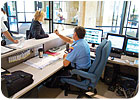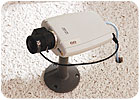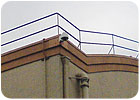

The main dispatch center in the Lake County Sheriff’s office in Waukegan, Ill., is the only location that can view all surveillance video cameras throughout five county buildings.
“When I got involved in this, I really thought there would be a backlash of big brother,” admitted Eric Lundahl, former director of homeland security for the Lake County Sheriff’s Office, Waukegan, Ill. “I’ll tell you truly, the hardest thing was dealing with the requests for cameras and camera coverage. It was exactly the opposite. I never received a bad comment about why so many cameras are installed. My biggest problem was scaling back and fitting that into the budget.”
That first phase of camera installation was followed by another financed with Homeland Security money. A total of 118 IP-based video surveillance cameras provide security at five widely separated Lake County buildings.
The 911 center and the emergency management center are in Libertyville, Ill., while the three other buildings – the Lake County Court and county administrative complex, the Babcox Justice Center, and the county clerk’s archival storage facility for voting records -— are in Waukegan Ill., approximately 10 miles away.
An existing fiber-optic backbone is used to transmit the output of the cameras, which are connected by Cat 5e cable and receive power over the Ethernet (PoE).
The output of the cameras is recorded on 10 networked hard drives located throughout the five buildings in a decentralized fashion. Video is accessible only by authorized laptop computer users.
Video motion detection is built into the cameras, as well as analytics that can begin recording when, for example, the area around a safe that had a video analytics box outlined around it is breached.
“We’ve had an incident in the parking garage where a person who took exception to a sentence took it out on our squad car, and we could identify that person,” Lundahl reported. “Once the cameras are in place, it’s a tremendous deterrent.”
Incidents of such vandalism or fights among litigants are much less frequent now because signs informing citizens of the video surveillance system are posted around the county buildings.

Locations throughout the five county buildings like the courthouse lobby in Waukegan only have clearance to view their own cameras.
THE RESEARCH
Lundahl was appointed by the Lake County sheriff as homeland security director in 2001 and began a vulnerability assessment of the county’s facilities in 2003, he related. The new director of homeland security for Lake County is Wayne Hunter.“We had a number of black-and-white stand-alone video systems that many times just recorded to a VHS machine located in the same office,” Lundahl remembered. “We obviously said that had to be changed.”
A video surveillance subcommittee was formed. “Frankly, I didn’t know what I wanted at that point,” Lundahl confessed. “We started by visiting two or three counties within Illinois; we visited two counties in Wisconsin and went to three or four businesses within Lake County.
“In everything, we kept hearing about IP-addressable network cameras,” he recalled. “A pretty good-sized company within Lake County had IP-addressed cameras, and it gave us an idea of what we were looking at.”
The tie-breaker was a visit to a county that had a new analog camera system with DVRs installed. Lundahl asked them, “’If you had unlimited money, what would you do?’ And he said, ‘I’d go digital IP-addressable,’ and do exactly what we just did.”
On the return trip from the county, Lundahl asked his associates, “How many times do we keep hearing this? Let’s just do it.”
When further calculations revealed that probably only 3 percent of the county’s fiber-optic bandwidth would be needed for the video, Lundahl thought IP-based cameras were “definitely doable.” But approval still was needed from the county board members.
“At first, they were quite alarmed by the initial cost, but that’s short-sighted,” Lundahl emphasized. “You need to take a look at the labor associated with wiring and coax and whatever cabling you’re using.
“I was asked, ‘If you’re spending X amount of dollars for a digital camera, why not buy one for one-third the price at Radio Shack?’” Lundahl remembered. “But you’re not getting the same quality, and labor kills you with installation costs. You weigh all that out, and a system like this looks favorable.”

This model of IP video camera, the 211 from Axis Communications, Chelmsford, Mass., is used throughout the county’s five buildings.
CAMERAS PREPROGRAMMED
The winner of the bidding process for the cameras was Pro-Com Systems, a division of Ballard Cos. Inc., Rockford, Ill. An IT company won the bid to install the wiring, on which Pro-Com also had bid, but Pro-Com’s bid was accepted as lowest for the cameras, explains Gary Klein, a Pro-Com technician.“They have somebody that pulls all their data cable for them; they did the data cabling, and we did all the camera mounting and installation,” Klein recalled. “That was the bid process because it was broken down into several different bids, and they took the bid for wiring.”
IP-based cameras from Axis Communications, Chelmsford, Mass., had been recommended to Lundahl, and ProCom used them on the job. Klein was able to preprogram all the cameras before going on-site, so installation was quickened.
“By doing it with a laptop, I was able to set up everything at each camera and get it ready to go, so when it got plugged into the network, it was all set and ready, and that worked out very well,” Klein related. “Once I went to the site, I did the final fine-tuning, because some cameras had to be mounted upside down or sideways, and things like that. I was able to have the laptop right there and get everything focused and set up properly.”
Klein found the PoE technology helpful when setting up the cameras. “The PoE switch enabled me to plug directly into the camera without having power, because the camera itself was powered through the switch,” he pointed out.
He also used a large uninterruptible power supply (UPS), so he did not need to find a power cord at each location to program the cameras.
Klein considers a unique feature of the job the number of cameras going into multiple servers in several geographic locations and the restrictions on accessing the different servers.
“The guard at one of the buildings only sees certain cameras on certain servers,” he noted. “There’s only one place that can view all the cameras — their main dispatch center — and then there’s several places that can view only what is considered their cameras.”
Expansion of the system is planned as budgets allow. “I can’t emphasize enough that my biggest role was being the bearer of bad news — we’re not doing your area yet,” Lundahl related.
“One of the neat things is the way we’ve set it up. If we decide a location is not worthwhile or we want a system moved from that area, we just pick up the camera and move it,” Lundahl pointed out.
Sidebar: On the Job
From Axis Communications, Chelmsford, Mass., www.axis.com- Axis 211 network/IP video cameras
- Videolarm model ACH13 series outdoor camera housing
- Uninterruptible power supply from American Power Conversion (APC), West Kingston, R.I.

A fence-mounted fiber-optic cable from Optellios Inc., Langhorne, Pa., and video domes are part of the security system at the NORAD/USAF Cheyenne Mountain complex.
Sidebar: Projects in the News
The FiberPatrol FP5100 system fromOptellios Inc., Langhorne, Pa., which actively monitors physical network pathways against intrusion, was installed around the NORAD/USAF Cheyenne Mountain complex in Colorado Springs, Colo., as a joint effort between Optellios Inc. and a national defense contractor already operating on the site. Using advanced technology, Optellios’ FiberPatrol system can analyze disturbances within the fiber-optic link to identify and locate potential threats to transmission integrity.â– â– â–
Adesta LLC, Omaha, Neb., has been awarded a multimillion-dollar, three-phase contract with the City of Long Beach to enhance security for the Port of Long Beach. Phase 1 will be optimization of the existing system, and recommendations, implementation and commissioning of an integrated system. Phase 2 encompasses development and implementation of a program for the integration of a scalable system management software component, which will have the capability to manage a combination of control, data, communication and detection devices/systems. Phase 3 will be development of a program for the implementation of a five-year integration plan that will be linked to a multi-agency/regional communications and data network.

Its new hybrid video surveillance system allows CBS Studio Center to add cameras more easily.
â– â– â–
The MESH Enterprise system fromViscount Systems Inc., Burnaby, British Columbia, has been selected by one of the largest freight forwarding and consolidation companies in the United States to secure a number of shipping facilities. Following the initial deployments, the customer plans to continue deploying systems throughout the U.S. and possibly internationally. Each site will include servers and readers with a centrally managed head office host.